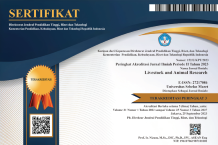Deteksi coronavirus pada kelelawar di Kabupaten Lamongan
Abstract
Objective: To obtain information about the presence of coronavirus in bats to find potential of new disease reservoir as well as not yet reported disease reservoir in Lamongan District. This research can be used by the government as a basis for planning and evaluating disease control programs and for researchers it can be used for vaccine and drug design, viral phylogenetic, analysis of viral distribution, and viral databases.
Methods: Sampling was carried out at 3 points representing different habitat types. The first point is at Pucakwangi Cave Babat Lamongan, the second is at Paciran Lamongan beach area, and the last is at the Mantup Forest Lamongan. Sampling was carried out using a mist net with the help of local workers. The netted bats were caught and put in a bag. Parameters observed included gender, morphometry, species, and detection of the presence of coronavirus. Detection of the virus using the oropharyngeal swab method, then the RNA samples were tested by RT-PCR and sequencing. The primer used to detect the coronavirus is primer forward 5′-CACGCAACTTGTTGTAATGCGT CAGAGA-3′ and primer reverse 5′- CACGTGCTTTTGCAGGCACTATACGAC-3′.
Results: Five species of bats obtained from 3 sampling locations namely Taphozous melanopogon, Chaerophon sp., Hipposideros sp., Cynopterus sp., Macroglossus sp. RT-PCR test of sample G1, G6, G8, P1, P2, P3, H1, H3, and H6, shows that no coronavirus from DNA sample amplified.
Conclusions: Negative result of Coronavirus detection by molecular analysis is not an indicator of no potential of species Taphozous melanopogon, Chaerophon sp., Hipposideros sp., Cynopterus sp., and Macroglossus sp. as a Coronavirus reservoir. Increasing the number of samples and expansion of study area still needed to obtain more comprehensive data.
Keywords
Full Text:
PDF (Bahasa Indonesia)References
Maryanto, I., A. A. S. Maharadatunkamsi, S. Wiantoro, E. Sulityadi, M. Yoneda, A. Suyanto, and J. Sugardjito. 2019. Checklist of the mammals of Indonesia: Scientific, English, Indonesian name, and distribution area table in indonesia including CITES, IUCN and Indonesian category for conservation. Lembaga Ilmu Pengetahuan Indonesia, Bogor.
Zhang, G., C. Cowled, Z. Shi, Z. Huang, K. A. Bishop-Lilly, X. Fang, J. W. Wynne, Z. Xiong, M. L. Baker, W. Zhao, and Tachedjian, M. 2013. Comparative analysis of bat genomes provides insight into the evolution of flight and immunity. Science. 339:456–460. Doi: 10.1126/science.1230835
Calisher, C. H., J. E. Childs, H. E. Field, K. v Holmes, and T. Schountz. 2006. Bats: important reservoir hosts of emerging viruses. Clinical microbiology reviews. 19:531–545. Doi: 10.1128/CMR.00017-06
Luis, A. D., D. T. S. Hayman, T. J. O’Shea, P. M. Cryan, A. T. Gilbert, J. R. C. Pulliam, J. N. Mills, M. E. Timonin, C. K. R. Willis, A. A. Cunningham, and Fooks, A. R. 2013. A comparison of bats and rodents as reservoirs of zoonotic viruses: are bats special?. Proceedings of the Royal Society B: Biological Sciences. 280:20122753. Doi: 10. 1098/rspb.2012.2753.
Pawan, J. L. 1936. Rabies in the vampire bat of Trinidad, with special reference to the clinical course and the latency of infection. Annals of Tropical Medicine & Parasitology. 30(4):401-422. Doi: 10.1080/00034983.1936.1 1684948
Drexler, J. F., V. M. Corman, M. A. Müller, G. D. Maganga, P. Vallo, T. Binger, F. Gloza-Rausch, V. M. Cottontail, A. Rasche, S. Yordanov, and A. Seebens. 2012. Bats host major mammalian paramyxoviruses. Nature communications. 3(1):1-13. Doi: 10. 1038/ncomms1796
Quan, P. L., C. Firth, J. M. Conte, S. H. Williams, C. M. Zambrana-Torrelio, S. J. Anthony, J. A. Ellison, A. T. Gilbert, I. V. Kuzmin, M. Niezgoda, and M. O. Osinubi. 2013. Bats are a major natural reservoir for hepaciviruses and pegiviruses. Proceedings of the National Academy of Sciences. 110 (20):8194-8199. Doi: 10.1073/pnas.13030371 10
Cutler, S. J., A. R. Fooks, and W. H. M. der Poel. 2010. Public health threat of new, reemerging, and neglected zoonoses in the industrialized world. Emerging infectious diseases. 16:1. Doi: 10.3201/eid1601.081467
Field, H. E., P. C. Barratt, R.J. Hughes, J. Shield, and N. D. Sullivan. 2000. Fatal case of Hendra virus infection in a horse in north Queensland: clinical and epidemiological features. Australian veterinary journal.
Memish, Z. A., N. Mishra, K. J. Olival, S. F. Fagb, V. Kapoor, J. H. Epstein, R. AlHakeem, A. Durosinloun, M. Al Asmari, A. Islam, and A. Kapoor. 2013. Middle East respiratory syndrome coronavirus in bats, Saudi Arabia. Emerging infectious diseases. 19(11):1819. Doi: 10.3201/ eid1911.131172
Leroy, E. M., B. Kumulungui, X. Pourrut, P. Rouquet, A. Hassanin, P. Yaba, A. Délicat, J. T. Paweska, J. P. Gonzalez, and R. Swanepoel. 2005. Fruit bats as reservoirs of Ebola virus. Nature. 438(7068):575-576. Doi: 10.1038/438575a
Zuckerkandl, E. and L. Pauling. 1965. Evolutionary divergence and convergence in proteins. In Evolving genes and proteins. Academic Press. p. 97-166. Doi: 10.1016/B978-1-4832-2734-4.50017-6
Anindita, P. D., M. Sasaki, A. Setiyono, E. Handharyani, Y. Orba, S. Kobayashi, I. Rahmadani, S. Taha, S. Adiani, M. Subangkit, and Nakamura, I. 2015. Detection of oronavirus genomes in Moluccan naked-backed fruit bats in Indonesia. Archives of virology. 160:1113– 1118. Doi: 10.1007/s007 05-015-2342-1
Febriani, W. D., U. Saepuloh, E. D. Ayu ningsih, R. S. Saputra, A. Purbatrapsila, M. J. Nangoy, T. A. Ransaleh, I. Wahyuni, S. Dako, R. Noviana, and D. Iskandriati. 2018. Bat Coronavirus of Pteropus alecto from Gorontalo Province, Indonesia. The International Journal of Tropical Veterinary and Biomedical Research. 3:36–42. Doi: 10.2 1157/ijtvbr.v3i2.12359
Badan Penelitian dan Pengembangan Kesehatan Kementerian Kesehatan RI. 2017. Pedoman Pengumpulan Data Reservoir (Kelelawar) di Lapangan, Riset Khusus Vektor dan Reservoir Penyakit. Lembaga Penerbit Badan Penelitian dan Pengembangan Kesehatan Kementerian Kesehatan RI. Jakarta.
de Souza Luna, L. K., V. Heiser, N. Regamey, M. Panning, J. F. Drexler, S. Mulangu, L. Poon, S. Baumgarte, B. J. Haijema, L. Kaiser, and Drosten, C. 2007. Generic detection of coronaviruses and differentiation at the prototype strain level by reverse transcription -PCR and nonfluorescent low-density microarray. Journal of clinical microbiology. 45:1049–1052. Doi: 10.1128/ JCM.02426-06
Lim, X. F., C. B. Lee, S. M. Pascoe, C. B. How, S. Chan, J. H. Tan, X. Yang, P. Zhou, Z. Shi, O. M. Sessions, and L. F. Wang. 2019. Detection and characterization of a novel bat-borne coronavirus in Singapore using multiple molecular approaches. The Journal of general virology. 100:1363. Doi: 10.1099/jgv.0.001307
Lacroix, A., V. Duong, V. Hul, S. San, H. Davun, K. Omaliss, S. Chea, A. Hassanin, W. Theppangna, S. Silithammavong, and Khammavong, K. 2017. Genetic diversity of coronaviruses in bats in Lao PDR and Cambodia. Infection, Genetics and Evolution. 48:10–18. Doi: 10.1016/j.meegid.2016.11.029
Nziza, J., T. Goldstein, M. Cranfield, P. Webala, O. Nsengimana, T. Nyatanyi, A. Mudakikwa, A. Tremeau-Bravard, D. Byarugaba, J. C. Tumushime, I. E, Mwikarago, I. Gafarasi, J. Mazet, K. Gilardi. 2020. Coronaviruses Detected in Bats in Close Contact with Humans in Rwanda. EcoHealth. 17:152–159. Doi: 10.1007/s10393-019-01458-8
Valitutto, M. T., O. Aung, K. Y. Naing Tun, M. E. Vodzak, D. Zimmerman, J. H. Yu, Y. T. Win, M. T. Maw, W. Z. Thein, H. H. Win, J. Dhanota, V. Ontiveros, B. Smith, A. Tremeau- Brevard, T. Goldstein, C. K. Johnson, S. Murray, J. Mazet. 2020. Detection of novel coronaviruses in bats in Myanmar. Plos One. 15(4): e0230802. Doi: 10.1371/journal.pone.0230802
Balboni, A. L. Gallina, A. Palladini, S. Prosperi, M. Battilani. 2012. A Real-Time PCR Assay for Bat SARS-Like Coronavirus Detection and Its Application to Italian Greater Horseshoe Bat Faecal Sample Surveys. The Scientific World Journal 2012(989514): 1-8. Doi:10.1100/2012/989514
Refbacks
- There are currently no refbacks.










